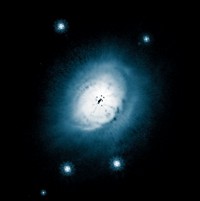Advertisement
Grab your lab coat. Let's get started
Welcome!
Welcome!
Create an account below to get 6 C&EN articles per month, receive newsletters and more - all free.
It seems this is your first time logging in online. Please enter the following information to continue.
As an ACS member you automatically get access to this site. All we need is few more details to create your reading experience.
Not you? Sign in with a different account.
Not you? Sign in with a different account.
ERROR 1
ERROR 1
ERROR 2
ERROR 2
ERROR 2
ERROR 2
ERROR 2
Password and Confirm password must match.
If you have an ACS member number, please enter it here so we can link this account to your membership. (optional)
ERROR 2
ACS values your privacy. By submitting your information, you are gaining access to C&EN and subscribing to our weekly newsletter. We use the information you provide to make your reading experience better, and we will never sell your data to third party members.
ACS Meeting News
Comet 67P reveals some answers and more mysteries
New data suggest scientists still have a lot to learn about how our solar system formed
by Sam Lemonick
April 7, 2021
| A version of this story appeared in
Volume 99, Issue 13

Almost 5 years after a European Space Agency mission to Comet 67P/Churyumov-Gerasimenko ended, scientists reported new findings about the comet’s chemistry at the American Chemical Society Spring 2021 meeting. Comets like 67P contain material that scientists think is largely unchanged since the very beginnings of our solar system. They “give us a view into how our solar system was when planets were still forming,” astrochemist Merel van ‘t Hoff of the University of Michigan says. Van ’t Hoff presided over some of the presentations.
The Rosetta spacecraft spent more than 2 years orbiting 67P. Its mass spectrometers and other instruments analyzed the chemicals blown off the comet by the solar wind. In a two-day Physical Chemistry Division session, scientists drew on these measurements to build a more detailed picture of the comet’s elements, isotopes, and molecules. The researchers said those data provide clues about how the comet and our solar system formed and reveal gaps in our understanding of astrochemistry.
On Monday, Victor M. Rivilla of the Spanish Astrobiology Center discussed measurements of phosphorus monoxide and phosphorus nitride, two of the few phosphorus-containing molecules so far identified in space. Phosphorus is a key element in many biological molecules, hence scientists’ interest in its astrochemical source. Rivilla said 67P has about 10 times as much PO as PN, suggesting PO may be an important source of Earth’s phosphorus.
On Tuesday, Kathrin Altwegg of the University of Bern reported that isotopes of volatile molecules hint at the solar system’s starting composition, early physical conditions such as temperature and density, and chemical processes. For instance, Altwegg said certain isotopic ratios observed for oxygen-containing molecules on 67P mean chemists can likely rule out water as the source of the comet’s oxygen. Her group also identified many hydrocarbon molecules, from methane up to decane and including alkanes, alkynes, aromatic molecules, and rings. She said more observations will be needed to figure out if these are being built from small molecules or if they’re the remnants of large carbonaceous particles breaking down.
Her collaborator Susanne Wampfler of the University of Bern described a similar story for nitrogen. Scientists hope comets like 67P can help explain why different bodies in our solar system and beyond have different ratios of 14N to 15N, with rocky planets richer in 15N compared to gaseous planets and the sun. Wampfler and other scientists think measuring the 14N/15N ratio in comets may reveal the source of this variability. One idea is that these objects have formed from isotopically distinct sources in the early stages of a solar system. But measurements of NH3, NO, and N2 on 67P show roughly equal nitrogen isotope ratios, she said, and provide no evidence for the proposed differences in nitrogen sources. Wampfler said it’s puzzling that these results look different from star-forming regions observed elsewhere in the universe, where scientists think conditions may be similar to the early solar system.
Hervé Cottin of Paris-Est Créteil University presented mass spectroscopic analysis of organic molecules in dust grains flung off 67P. For these solids, Cottin’s group did not find individual hydrocarbon molecules. Instead they detected insoluble organic matter, a tangle of hydrocarbon chains and rings. Their findings suggest the material 67P is made of might be an important reservoir of carbon and organic matter in our solar system, but the lack of molecules such as glycine, which is found in meteorites, suggested to Cottin that there are reactions missing in our model of solar system chemistry.
Wrapping up the series, Stefanie Milam of NASA Goddard Space Flight Center looked ahead to the launch of the James Webb Space Telescope (JWST) later this year. Ground-based telescopes provide most of today’s observations of comets and young solar systems. But Earth’s atmosphere blocks parts of the electromagnetic spectrum and inhibits researchers’ ability to identify certain molecules near these distant objects. With JWST in orbit, scientists will be able to make more, better observations of comets and continue to fill in the gaps in our astrochemical knowledge, she said.





Join the conversation
Contact the reporter
Submit a Letter to the Editor for publication
Engage with us on Twitter